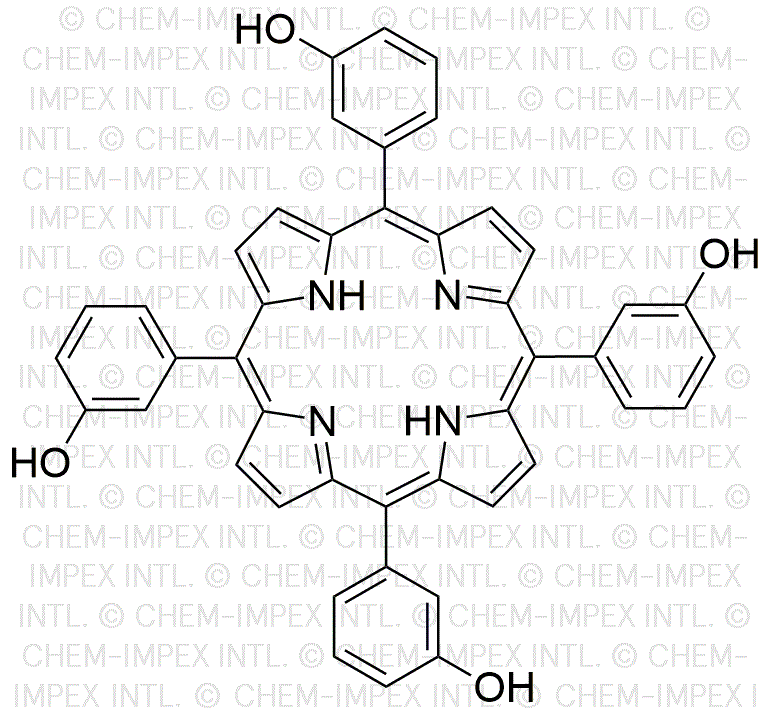5,10,15,20-(Tetra-3-hydroxyphenyl)porphyrin is widely utilized in research focused on:
- Photodynamic Therapy (PDT): This compound is effective in treating certain types of cancers by generating reactive oxygen species when exposed to light, helping to destroy cancer cells while minimizing damage to surrounding tissues.
- Solar Energy Conversion: It can be used in dye-sensitized solar cells, enhancing the efficiency of converting sunlight into electricity due to its strong light-absorbing properties.
- Fluorescent Probes: The compound serves as a fluorescent marker in biological imaging, allowing researchers to visualize cellular processes and structures with high precision.
- Antioxidant Applications: Its antioxidant properties make it useful in formulations aimed at protecting cells from oxidative stress, which is beneficial in various health and cosmetic products.
- Environmental Monitoring: It can be employed in detecting pollutants in water and air, aiding in environmental protection efforts by providing a means to monitor and assess contamination levels.
General Information
Properties
Safety and Regulations
Applications
5,10,15,20-(Tetra-3-hydroxyphenyl)porphyrin is widely utilized in research focused on:
- Photodynamic Therapy (PDT): This compound is effective in treating certain types of cancers by generating reactive oxygen species when exposed to light, helping to destroy cancer cells while minimizing damage to surrounding tissues.
- Solar Energy Conversion: It can be used in dye-sensitized solar cells, enhancing the efficiency of converting sunlight into electricity due to its strong light-absorbing properties.
- Fluorescent Probes: The compound serves as a fluorescent marker in biological imaging, allowing researchers to visualize cellular processes and structures with high precision.
- Antioxidant Applications: Its antioxidant properties make it useful in formulations aimed at protecting cells from oxidative stress, which is beneficial in various health and cosmetic products.
- Environmental Monitoring: It can be employed in detecting pollutants in water and air, aiding in environmental protection efforts by providing a means to monitor and assess contamination levels.
Documents
Safety Data Sheets (SDS)
The SDS provides comprehensive safety information on handling, storage, and disposal of the product.
Product Specification (PS)
The PS provides a comprehensive breakdown of the product’s properties, including chemical composition, physical state, purity, and storage requirements. It also details acceptable quality ranges and the product's intended applications.
Certificates of Analysis (COA)
Search for Certificates of Analysis (COA) by entering the products Lot Number. Lot and Batch Numbers can be found on a product’s label following the words ‘Lot’ or ‘Batch’.
Numéro de catalogue
Numéro de lot/série
Certificates Of Origin (COO)
This COO confirms the country where the product was manufactured, and also details the materials and components used in it and whether it is derived from natural, synthetic, or other specific sources. This certificate may be required for customs, trade, and regulatory compliance.
Numéro de catalogue
Numéro de lot/série
Safety Data Sheets (SDS)
The SDS provides comprehensive safety information on handling, storage, and disposal of the product.
DownloadProduct Specification (PS)
The PS provides a comprehensive breakdown of the product’s properties, including chemical composition, physical state, purity, and storage requirements. It also details acceptable quality ranges and the product's intended applications.
DownloadCertificates of Analysis (COA)
Search for Certificates of Analysis (COA) by entering the products Lot Number. Lot and Batch Numbers can be found on a product’s label following the words ‘Lot’ or ‘Batch’.
Numéro de catalogue
Numéro de lot/série
Certificates Of Origin (COO)
This COO confirms the country where the product was manufactured, and also details the materials and components used in it and whether it is derived from natural, synthetic, or other specific sources. This certificate may be required for customs, trade, and regulatory compliance.


